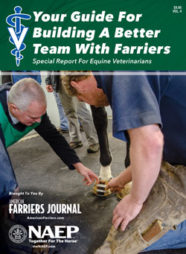That trusty pair of nippers you depend on so often will gradually dull with use, until one day you realize that you’re having a tougher time trimming the hoof wall than you should. It’s best to sharpen those nippers before that day arrives.
Exactly how you go about that will determine whether the nippers return to peak performance for an extended period or if they’re a big step closer to the trash bin.
“What destroys the most nippers is the way that horseshoers file them,” says Donald Jones. As an International Horseshoeing Hall Of Fame farrier and the owner of NC Tool Company, he ought to know. He’s used a lot of nippers over the years, and he routinely refurbishes the tools sent in by farriers across the country.
A good sharpening that prolongs the life of the nippers isn’t difficult, Jones says. “The secret to making the nippers cut well is to keep the shoulder area thin. Most people get their edges too blunt,” he says. “The actual front edge, the cutting edge, will feel sharp, but there’s so much metal back on the shoulder that it makes for resistance when you’re trying to cut the hoof.”
He offers the following advice for best results:
- Secure the nippers horizontally, with the lower handle firmly in a vise. Pull the top handle upward to open the head of the nippers and expose the underside of the jaws.
- Identify the area to be filed. Always file the underside, or inside, of the nipper jaws. Although a few strokes may be needed on the front cutting edge, most of the filing should run from the front edge through the back shoulder. (See Photos 1 and 2.)
- Use a two-handed grip on the file for long, flat strokes. (See Photo 3.) Strive for a sharp cutting edge that runs smoothly back into the shoulder of the nippers without any sudden angles along the way. (See Photo 4.)
- Repeat the process for the second side of the nipper jaws.
- Avoid damaging the corners of the jaws, which help pierce the hoof wall during trimming.
- The stops down in the handles come together at the same time as the cutting edges to prevent the cutting surfaces from blunting one another or overlapping. If you take a bit of metal off the cutting edges when you sharpen them, then you have to take a little off the stops, too, so the cutting edges close correctly.

OFF THE SHOULDERS. The inside shoulder of the jaw, especially the area just behind the cutting edge (marked by a black stripe in this photo), should be filed to provide a smooth transition from the cutting edge and eliminate resistance during trimming.

FILING FORM. Long, smooth strokes will help eliminate the sudden thickening of the shoulder that hinders hoof trimming. Mounting in a vise is essential.

LIGHT ON THE EDGES. The cutting edge at the very front of the nipper jaw (as indicated by the pen point) should be filed very little during sharpening.
Even with proper sharpening, nippers eventually need professional resetting of the handles and tightening or replacing of the rivet. There are two reasons for this, Jones says:
- After adjusting the stoppers a few times as part of the sharpening, the handles start getting closer together. (See Photo 5.) Send the tool to a professional when the handles become too close to use the nippers efficiently or comfortably.
- After nippers have been sharpened a few times, a gap appears between the cutting edges. (See Photo 6.) The nippers should be sent to a professional for resetting.

HANDLES COUNT, TOO. Properly spaced handles on the nippers at the top provide good working leverage. The handles on the nippers at the bottom are too close together and must be reset by a professional.

A PERFOMANCE GAP. The slight gap between the cutting edges when the handles are closed will make cutting hoof walls difficult. These nippers need professional resetting.

SMOOTH TRANSITIONS. Note the smooth transition from the cutting edge through the inside shoulder. This makes it easier for the nippers to move through the hoof wall.
“You should be able to sharpen nippers several times before you need to send them off for reworking,” Jones says, “and then they’ll work as good as new.”






